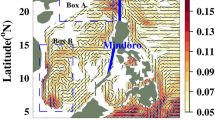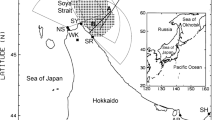Abstract
Seasonal pathway of the Tsugaru Warm Current (TWC), coastal boundary current flowing eastward from the Sea of Japan to the North Pacific Ocean, is investigated using data of surface currents measured by high-frequency ocean radars for the period 2014–2020. The TWC takes a pathway along the center of Tsugaru strait during summer season (41.64ºN), while during winter season the TWC moves to south to flow along the southern coast (41.55ºN). These pathways are associated with seasonal outflow modes known as “Gyre mode” and “Coastal mode,” respectively. Seasonal changes in current velocity, characterized by intensified flow in summer and autumn seasons and weakened flow in winter season, are well correlated with seasonal changes of sea level difference between Fukaura and Hakodate. However, this clear relationship is not seen at the eastern exit of the strait (141.5ºE). There is a shallow sill that extends northward from the southern coast. HFR further reveals that Coastal mode is locally intensified and widened when passing through this sill. These TWC’s responses are qualitatively explained by mass conservation for barotropic flow that flows in a horizontal two-dimensional channel with sea floor depth change. These responses over the sill are not seen during Gyre mode because the northward shift keeps the pathway away from the sill. During the Coastal mode, there are some cases in which the TWC does not ride on the sill but takes a pathway around the sill. Such patterns are seen when the TWC is weak, thus a weak Coastal mode.
















Similar content being viewed by others
References
Abe H, Sampei M, Hirawake T, Waga H, Nishino S, Ooki A (2019) Sediment-associated phytoplankton release from the seafloor in response to wind-induced barotropic currents in the Bering Strait. Front Mar Sci 6:97. https://doi.org/10.3389/fmars.2019.00097
Abe H, Sasaki K, Yasui T, Wakita M (2020) Observation of Tsugaru warm current by high frequency radar and preliminary result for its prediction. Kaiyo Monthly 52(7):312–316 ((in Japanese))
Barrick DE, Lipa BJ (1997) Evolution of bearing determination of HF current mapping radars. Oceanography 10:72–75
Barrick DE, Evans MW, Weber BL (1977) Ocean surface currents mapped by radar. Science 198:138–144. https://doi.org/10.1126/science.198.4313.138
Conlon DM (1982) On the outflow modes of the Tsugaru Warm Current. Mer 20:60–64
Ebuchi N, Fukamachi Y, Ohshima KI, Shirasawa K, Ishikawa M, Takatsuka T, Daibo T, Wakatsuchi M (2006) Observation of the Soya Warm Current using HF ocean radar. J Oceanogr 62:47–61. https://doi.org/10.1007/s10872-006-0031-0
Fukudome K-I, Yoon J-H, Ostrovskii A, Takikawa T, Han I-S (2010) Seasonal volume transport variation in the Tsushima Warm Current through the Tsushima Straits from 10 years of ADCP observations. J Oceanogr 66:539–551. https://doi.org/10.1007/s10872-010-0045-5
Han S, Hirose N, Kida S (2018) The role of topographically induced form drag on the channel flows through the East/Japan Sea. J Geophys Res Oceans 123:6091–6105. https://doi.org/10.1029/2018JC013903
Hanawa K, Mitsudera H (1987) Variation of water system distribution in the Sanriku coastal area. J Oceanogr 42:435–446. https://doi.org/10.1007/BF02110194
Ida S, Yamashita S, Isoda Y, Kobayashi N (2016) Inflow process of low potential vorticity water originating from the intermediate waters of the Japan Sea into the Tsugaru Strait. Oceanogr Japan 25(4):101–122. https://doi.org/10.5928/kaiyou.25.4_101 (in Japanese with English abstract)
Iino R, Isoda Y, Yahaba H (2009) Sea level difference inducing the passage-flow through the Tsugaru Strait. Umi to Sora 85:1–19 ((in Japanese with English abstract))
Isobe A (1999) On the origin of the Tsushima Warm Current and its seasonality Cont. Shelf Res 19(1):117–133
Isoda Y, Baba K (1998) Tides and tidal currents in the Tsugaru Strait. Bull Facul Fish Hokkaido University 49(3):117–130 ((in Japanese with English abstract))
Ito T, Togawa O, Ohnishi M, Isoda Y, Nakayama T, Shima S, Kuroda H, Iwahashi M, Sato C (2003) Variation of velocity and volume transport of the Tsugaru Warm Current in the winter of 1999–2000. Geophys Res Lett 30:1678 (HTTPS://doi.org/10.1029/2003GL017522)
Kaneko H, Sasaki K, Abe H, Tanaka T, Wakita M, Watanabe S, et al (2021) The role of an intense jet in the Tsugaru Strait in the formation of the outflow gyre revealed using high-frequency radar data. Geophys Res Lett 48: e2021GL092909. https://doi.org/10.1029/2021GL092909
Kida S, Qiu B, Yang J, Lin X (2016) The annual cycle of the japan sea throughflow. J Phys Oceanogr 46:23–39. https://doi.org/10.1175/JPO-D-15-0075.1
Kobayashi N, Ohta S, Isoda Y, Shouji K, Kudou I, Aramaki T (2014) The bifurcation of the Tsugaru Gyre over the Hidaka shelf slope. Umi Sora (sea and Sky) 90:1–10
Kubokawa A (1991) On the behavior of outflows with low potential vorticity from a sea strait. Tellus 43A:168–176
Kuroda H, Isoda YM, Ohnishi M, Iwahashi M, Satoh C, Nakayama T, Ito T, Iseda K, Nishizawa K, Shima S, Togawa O (2004) Examination of harmonic analysis methods using semi-regular sampling data from an ADCP installed on a regular ferry: Evaluation of tidal and residual currents in the eastern mouth of the Tsugaru Strait. Umi Kenkyu 13:553–564
Nishida Y, Kanomata I, Tanaka I, Sato S, Takahashi S, Matsubara H (2003) Seasonal and interannual variations of the volume transport through the Tsugaru Strait. Umi Kenkyu 12:487–499 ((in Japanese with English abstract))
Ohshima KI, Simizu D, Ebuchi N, Morishima S, Kashiwase H (2017) Volume, heat, and salt transports through the Soya Strait and their seasonable and interannual variations. J Phys Oceanogr 47:999–1019. https://doi.org/10.1175/JPO-D-16-0210.1
Ohta S, Isoda Y, Yoshimura S, Syouji K, Arita S, Kawano K, Xiaorong F, Kobayashi N (2015) Internal tidal waves generated over the sill topography in the Tsugaru Strait. Umi to Sora 90:63–68 (in Japanese with English abstract)
Ohtani K, Akiba Y, Yoshida K, Ohtsuki T (1971) Studies on the change of the hydrographic conditions in the Funka Bay III. Oceanic conditions of the Funka Bay occupied by the Oyashio waters. Bull Fac Fish Hokkaido Univ 22:129–142 ((in Japanese with English abstract and legends))
Paduan JD, Washburn L (2013) High-frequency radar observations of ocean surface currents. Annu Rev Mar Sci 5:115–136. https://doi.org/10.1146/annurev-marine-121211-172315
Pratt LJ, Lundberg PA (1991) Hydraulics of rotating strait and sill flow. Annu Rev Fluid Mech 23:81–106
Rosa AL, Isoda Y, Uehara K, Aiki T (2007) Seasonal variations of water system distribution and flow patterns in the southern sea area of Hokkaido, Japan. J Oceanogr 63:573–588. https://doi.org/10.1007/s10872-007-0051-4
Shimizu M, Isoda Y, Baba K (2001) A late winter hydrography in Hidaka bay, South of Hokkaido, Japan. J Oceanogr 57:385–395. https://doi.org/10.1023/A:1021585315008
Takikawa T, Yoon JH (2005) Volume transport through the Tsushima Straits estimated from sea level difference. J Oceanogr 61:699–708. https://doi.org/10.1007/s10872-005-0077-4
Takikawa T, Yoon J-H, Cho K-D (2005) The Tsushima warm current through Tsushima straits estimated from ferryboat ADCP data. J Phys Oceanogr 35:1154–1168. https://doi.org/10.1175/JPO2742.1
Thompson RO (1983) Low-pass filters to suppress inertial and tidal frequencies. J Phys Oceanogr 13:1077–1083. https://doi.org/10.1175/1520-0485(1983)013%3c1077:LPFTSI%3e2.0.CO;2
Toba Y, Tomizawa K, Kurasawa Y, Hanawa K (1982) Seasonal and year-to-year variability of the Tsushima–Tsugaru warm current system with its possible cause. Mer 20:41–51
Wakita M, Sasaki K, Nagano A, Abe H, Tanaka T, Nagano K, et al. (2021) Rapid reduction of pH and CaCO3 saturation state in the Tsugaru Strait by the intensified Tsugaru Warm Current during 2012–2019. Geophys Res Lett 48: e2020GL091332. https://doi.org/10.1029/2020GL091332
Whitehead JA Jr, Miller AR (1979) Laboratory simulation of the gyre in the Alboran Sea. J Geophys Res 84(C7):3733–3742
Yoshikawa Y, Masuda A, Marubayashi K, Ishibashi M, Okuno A (2006) On the accuracy of HF radar measurement in the Tsushima Strait. J Geophys Res Oceans 111:C04009. https://doi.org/10.1029/2005JC003232
Zhang W, Ebuchi N, Fukamachi Y, Yoshikawa Y (2016) Estimation of wind drift current in the Soya Strait. J Oceanogr 72:299–311. https://doi.org/10.1007/s10872-015-0333-1
Acknowledgements
We thank the chief editor (Dr. Ebuchi), handling editor (Dr. Takikawa), and two anonymous reviewers who provided valuable comments that contributed to the improvement of this manuscript. We are indebted to the captains and crews on board training ships Ushio-Maru, Oshoro-Maru, and the staff of JAMSTEC and Marine Work Japan, Ltd., for their cooperation for the CTD, ship-board ADCP, and drifting buoy observations. Sea level data at Fukaura and Hakodate stations are provided by Japan Meteorological Agency, and at Hachinohe by Sendai Research and Engineering Office for Port and Airport, Tohoku Regional Development Bureau, Ministry of Land, Infrastructure, Transport and Tourism. We are grateful to Dr. Isoda, Dr. Watanabe, Dr. Kaneko for their fruitful comments and discussions. This work was supported by the Sasakawa Scientific Research Grant from the Japan Science Society (grant number 2019-2038), in part by the Collaborative Research Program of Research Institute for Applied Mechanics, Kyushu University, and the Grant for Joint Research Program of the Institute of Low Temperature Science, Hokkaido University.
Author information
Authors and Affiliations
Corresponding author
Rights and permissions
About this article
Cite this article
Yasui, T., Abe, H., Hirawake, T. et al. Seasonal pathways of the Tsugaru Warm Current revealed by high-frequency ocean radars. J Oceanogr 78, 103–119 (2022). https://doi.org/10.1007/s10872-022-00631-y
Received:
Revised:
Accepted:
Published:
Issue Date:
DOI: https://doi.org/10.1007/s10872-022-00631-y




